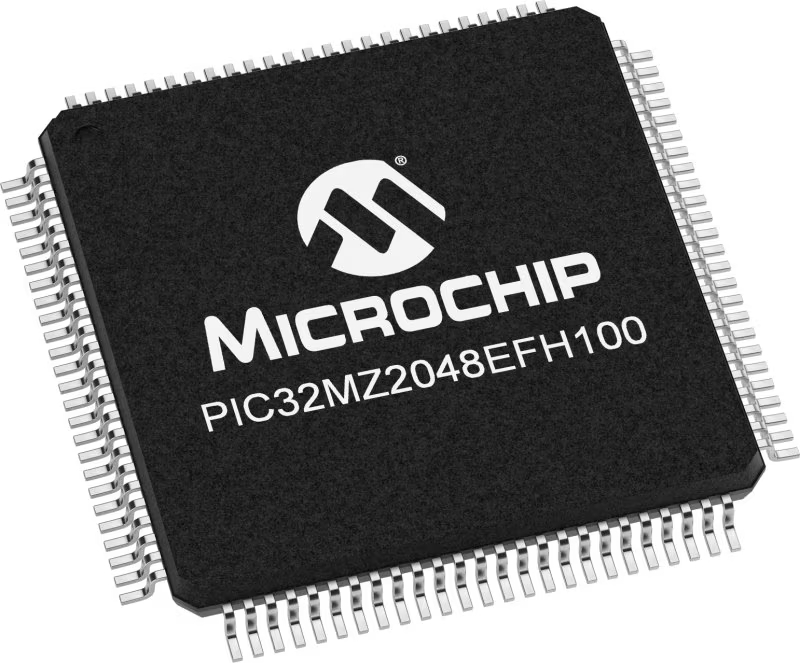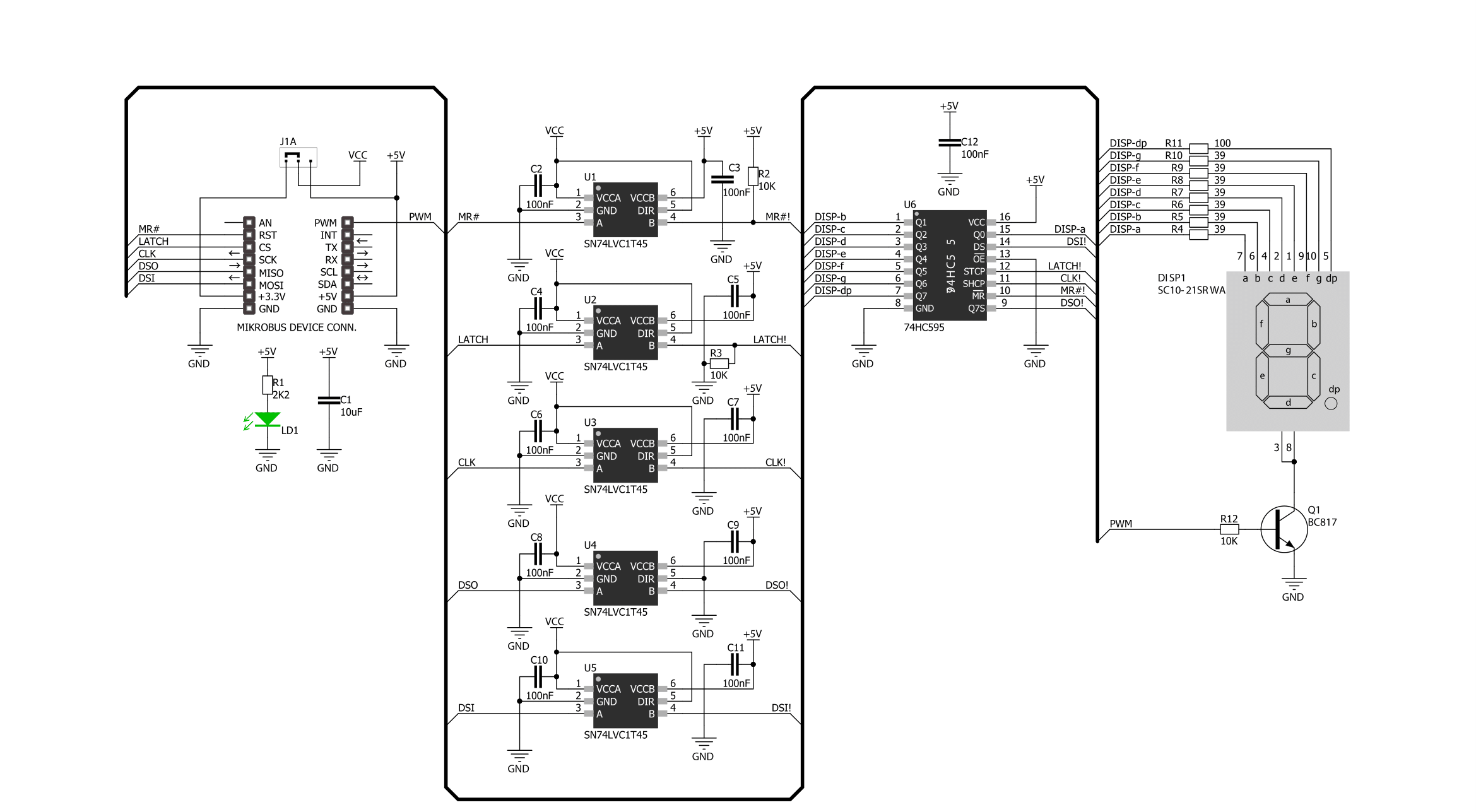Our seven-segment LED display is designed to illuminate information with clarity and precision, making it the ideal choice for all your numeric readout needs
A
A
Hardware Overview
How does it work?
BIG 7-Seg R Click is based on the SC10-21SRWA, a single-digit numeric display from Kingbright. This super bright red source color device is made with a Gallium Aluminium Arsenide red light-emitting diode. It features low current operation, high light output, excellent character appearance, and is mechanically rugged. The display works on 5V and has a common cathode as its internal design. It consists of seven red LED segments that form an 8 number and the eighth segment as a decimal point, or DP. The communication between the host MCU and the Big 7-Seg R Click is established via a 4-Wire SPI serial interface and the 8-bit
serial-IN, parallel-OUT 74HC595, a shifter register with 3-state output registers from Texas Instruments. The shift register provides a separate clock for both the shift and the storage register. In addition, you can set all shift register values to zero by applying logic LOW state on pin MR, and this function is independent of all clocks. One of the main features of the Big 7-Seg R Click is light intensity management. The light intensity can be set over the PWM pin. The SC10-21SRWA display is a 5V-only device. To work with 3.3V logic MCUs, this Click board™ features five SN74LVC1T45s, single-bit dual-supply bus transceivers with
configurable voltage translation, and 3-state outputs from Texas Instruments. These noninverting transceivers use two separate configurable power-supply rails and are designed for asynchronous communication between the two data buses. This Click board™ can operate with either 3.3V or 5V logic voltage levels selected via the DATA SEL jumper. This way, both 3.3V and 5V capable MCUs can use the communication lines properly. Also, this Click board™ comes equipped with a library containing easy-to-use functions and an example code that can be used as a reference for further development.
Features overview
Development board
Flip&Click PIC32MZ is a compact development board designed as a complete solution that brings the flexibility of add-on Click boards™ to your favorite microcontroller, making it a perfect starter kit for implementing your ideas. It comes with an onboard 32-bit PIC32MZ microcontroller, the PIC32MZ2048EFH100 from Microchip, four mikroBUS™ sockets for Click board™ connectivity, two USB connectors, LED indicators, buttons, debugger/programmer connectors, and two headers compatible with Arduino-UNO pinout. Thanks to innovative manufacturing technology,
it allows you to build gadgets with unique functionalities and features quickly. Each part of the Flip&Click PIC32MZ development kit contains the components necessary for the most efficient operation of the same board. In addition, there is the possibility of choosing the Flip&Click PIC32MZ programming method, using the chipKIT bootloader (Arduino-style development environment) or our USB HID bootloader using mikroC, mikroBasic, and mikroPascal for PIC32. This kit includes a clean and regulated power supply block through the USB Type-C (USB-C) connector. All communication
methods that mikroBUS™ itself supports are on this board, including the well-established mikroBUS™ socket, user-configurable buttons, and LED indicators. Flip&Click PIC32MZ development kit allows you to create a new application in minutes. Natively supported by Mikroe software tools, it covers many aspects of prototyping thanks to a considerable number of different Click boards™ (over a thousand boards), the number of which is growing every day.
Microcontroller Overview
MCU Card / MCU

Architecture
PIC32
MCU Memory (KB)
2048
Silicon Vendor
Microchip
Pin count
100
RAM (Bytes)
524288
Used MCU Pins
mikroBUS™ mapper
Take a closer look
Click board™ Schematic

Step by step
Project assembly
Track your results in real time
Application Output
1. Application Output - In Debug mode, the 'Application Output' window enables real-time data monitoring, offering direct insight into execution results. Ensure proper data display by configuring the environment correctly using the provided tutorial.

2. UART Terminal - Use the UART Terminal to monitor data transmission via a USB to UART converter, allowing direct communication between the Click board™ and your development system. Configure the baud rate and other serial settings according to your project's requirements to ensure proper functionality. For step-by-step setup instructions, refer to the provided tutorial.

3. Plot Output - The Plot feature offers a powerful way to visualize real-time sensor data, enabling trend analysis, debugging, and comparison of multiple data points. To set it up correctly, follow the provided tutorial, which includes a step-by-step example of using the Plot feature to display Click board™ readings. To use the Plot feature in your code, use the function: plot(*insert_graph_name*, variable_name);. This is a general format, and it is up to the user to replace 'insert_graph_name' with the actual graph name and 'variable_name' with the parameter to be displayed.

Software Support
Library Description
This library contains API for BIG 7-SEG R Click driver.
Key functions:
big7seg_display_off- Turn OFF BIG 7-SEG displaybig7seg_write_data_number- Function write numberbig7seg_write_data_character- Function write character
Open Source
Code example
The complete application code and a ready-to-use project are available through the NECTO Studio Package Manager for direct installation in the NECTO Studio. The application code can also be found on the MIKROE GitHub account.
/*!
* \file
* \brief Big7Seg Click example
*
* # Description
* This application sets seven-segment leds on the display.
*
* The demo application is composed of two sections :
*
* ## Application Init
* Driver initializaion and turning on the display
* by setting PWM pin to logic 1 and prepare to communcation via SPI.
*
* ## Application Task
* This example shows functionality of the BIG 7-SEG R click,
* shows number or character on display.
*
* \author MikroE Team
*
*/
// ------------------------------------------------------------------- INCLUDES
#include "board.h"
#include "log.h"
#include "big7seg.h"
// ------------------------------------------------------------------ VARIABLES
static big7seg_t big7seg;
static log_t logger;
// ------------------------------------------------------ APPLICATION FUNCTIONS
void application_init ( void )
{
log_cfg_t log_cfg;
big7seg_cfg_t cfg;
/**
* Logger initialization.
* Default baud rate: 115200
* Default log level: LOG_LEVEL_DEBUG
* @note If USB_UART_RX and USB_UART_TX
* are defined as HAL_PIN_NC, you will
* need to define them manually for log to work.
* See @b LOG_MAP_USB_UART macro definition for detailed explanation.
*/
LOG_MAP_USB_UART( log_cfg );
log_init( &logger, &log_cfg );
log_info( &logger, "---- Application Init ----" );
// Click initialization.
big7seg_cfg_setup( &cfg );
BIG7SEG_MAP_MIKROBUS( cfg, MIKROBUS_1 );
big7seg_init( &big7seg, &cfg );
big7seg_set7seg( &big7seg );
Delay_100ms( );
}
void application_task ( )
{
uint8_t counter;
big7seg_reset7seg( &big7seg );
big7seg_display_on( &big7seg );
Delay_1sec( );
big7seg_write_data( &big7seg, 0x40 );
Delay_1sec( );
big7seg_write_data_character( &big7seg, 'B' );
Delay_1sec( );
big7seg_write_data_character( &big7seg, 'I' );
Delay_1sec( );
big7seg_write_data_character( &big7seg, 'G' );
Delay_1sec( );
big7seg_write_data( &big7seg, 0x08 );
Delay_1sec( );
big7seg_write_data_number( &big7seg, 7 );
Delay_1sec( );
big7seg_write_data( &big7seg, 0x40 );
Delay_1sec( );
big7seg_write_data_character( &big7seg, 'S' );
Delay_1sec( );
big7seg_write_data_character( &big7seg, 'E' );
Delay_1sec( );
big7seg_write_data_character( &big7seg, 'G' );
Delay_1sec( );
big7seg_write_data( &big7seg, 0x00 );
Delay_1sec( );
for ( counter = 65; counter < 91; counter ++ )
{
big7seg_write_data_character( &big7seg, counter );
Delay_1sec( );
}
big7seg_display_off( &big7seg );
Delay_1sec( );
}
void main ( void )
{
application_init( );
for ( ; ; )
{
application_task( );
}
}
// ------------------------------------------------------------------------ END

































